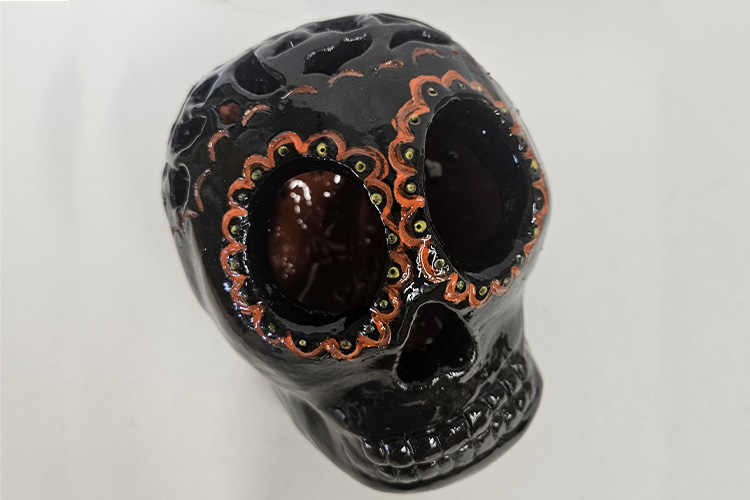
Senior Meredith Shukert created a sugar skull in her ceramics class in honor of Day of the Dead. photo by Lisa Freedberg
From sugar skulls to marigolds, Day of the Dead captures the essence of a tradition that celebrates life and remembrance.
Dia de los Muertos, which translates to Day of the Dead, has been celebrated around the world for many years. Many of the countries that celebrate this holiday are Spanish-speaking countries like Mexico, Spain, Ecuador, and more. This holiday has a major cultural significance to those who celebrate it.
As one might be able to gather from its title, Day of the Dead is a day where family and friends come together to commemorate their loved ones who have passed away. This holiday lasts 24 hours and allows the spirits of adults, children, and even pets to rejoin the living for that duration of time. The holiday begins at 12:00 a.m. on November 1st and ends at 12:00 a.m. on November 2nd.
On the days leading up to Day of the Dead, families will set up colorful decorations like papel picado – which literally translates to pierced paper – and sugar skulls. Papel picado is created by stacking colored tissue paper in layers, then cutting a design out and hanging it up. At Thomas Jefferson High School, level two ceramics students had a project to create skulls. Several students created sugar skulls in honor of Day of the Dead this year. Families will also set up altars called ofrendas. On these altars, families will place candles, food, marigolds, and pictures of their loved ones. These items can also be placed on the graves of the deceased. Once Day of the Dead finally arrives, many people will dress up and paint their face to look like a skeleton. Women wear colorful dresses while the men wear black suits.
Dia de los Muertos has been celebrated for about 3,000 years, with its earliest historical origins in pre-Columbian Mesoamerica. Mesoamericans, such as the Aztects and Nahuas, believed that once someone had died, they traveled to Chicunamictlán, the land of the dead. The deceased would then have to go through nine challenges that would take many years to complete. Only once that person has completed all the challenges, their soul would finally reach Mictlán, the final resting place. During August, Nahua people would perform rituals in honor of the dead. During these rituals, family members offered food, water, and tools to the deceased to help them along their journey in the afterlife.
Day of the Dead is very popular in Mexico, and every year at the Puerta de Leones in Chapultepec Park, a parade takes place to celebrate the holiday. Lasting around 4.5 hours, the parade consists of live music, giant floats, bike rides, and many more fun activities. This year, the parade took place on Saturday, November 4. It began at 2:00 p.m. and ended around 6:30 p.m..
Day of the Dead is a vibrant and meaningful celebration that honors the lives of loved ones who have passed away. It’s a beautiful reminder that even death can bring people together through love and memories and inspires those who celebrate this holiday to embrace life and cherish the memories they hold dear.